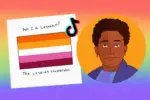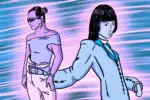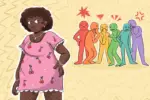American culture is one to be reveled in. There’s entertainment, sports, news, fashion, technology, slang and so much more that even Americans can’t get enough of it. But what I find interesting is the irony behind a country whose culture previously dismissed sexual expression now embraces just about anything sexual. What often gets erased is known as asexuality, which is really an umbrella term for where many individuals fall on the spectrum of sexuality. Today, I want to spread awareness of what asexuality is all about since it seems more and more people are coming to terms with their sexualities and what it means for them.
It’s completely normal to be asexual. Unfortunately, people often assume that one must’ve gone through something in their life that caused them to be this way or that something is wrong with that person. Whether the assumptions are abstinence, celibacy, sexual repression, trauma, loss or lack of libido, inability to find a partner or fear of intimacy, they are often not the case at all for someone’s reason to identify as asexual.
In most recent years, the existence of the spectrum of sexuality has stunned quite a few folks. “How could I like both men and women? Is something wrong here, or am I really a closeted lesbian? Bisexual is a term for confused individuals only. How could I not experience sexual attraction until I formed an emotional connection with them? Am I defective? Is demisexual just a term people use to seem more relevant? How could anyone ever love someone who isn’t romantic? Don’t these people believe in happily ever after? Aromanticism is just a term for those who can’t commit.” These thoughts and beliefs are very much real. I’ve heard them and honestly have thought them myself.
The thing is, there aren’t many open avenues for people to express their sexualities. Yes, in recent years, the law allowing gay people to get married has been embraced by many younger generations. And it seems with each passing year, identifying as queer is acceptable but only under certain circumstances. There are the basics: gay, straight, bi and trans. The term most widely known is the LGBTQ+ community, but wait, there’s more? Yes, indeed there is.
See, as I mentioned before, sexuality exists on a spectrum, and so does asexuality. People are probably thinking, why haven’t I heard more about this? Well, let’s just say it was difficult enough to convince people that some people like the same sex and identity as the opposite gender, so trying to make them wrap their minds around a lack of sexual attraction was no easy feat.
While it’s completely okay to not understand what is brewing within the queer community at every given moment, I believe it is important to understand the people that one wants in their life. They should attempt to acquaint themselves with the terminology that their loved ones identify with.
There is also the argument of creating too many labels to define someone; we are who we are, isn’t that enough? One might think so, but labels are actually constructive when exploring identity and when communicating with a potential partner, friend or family member. Let’s take a deep dive into asexuality as a whole and then make some pit stops by the specific terms.
Asexual Terminology
Asexuality is an umbrella term for many people who identify somewhere on the spectrum of sexuality.
People can familiarize themselves with queer terminology provided by accessible resources like The Trevor Project, an important suicide prevention and crisis organization for young LGBTQ+ people; Healthline, which covers topics of wellness; and GLAAD, an organization that’s mission is sharing narratives and leading discussions on LGBTQ+ people.
According to The Trevor Project, “Asexual people (or aces) experience little or no sexual attraction. While most asexual people desire emotionally intimate relationships, they are not drawn to sex as a way to express that intimacy.” This doesn’t mean that an asexual will abstain from sex altogether. It may sound confusing, and many validly ask, “Then why choose to participate in sex if one doesn’t desire it?” It’s important to elaborate that asexual individuals can still enjoy the act of sex, and some do engage in sexual interaction, whether to fulfill their partner’s sexual desires, enhance their emotional bond with their partner or just relieve themselves of their natural libido.
Specific identities that fall under the asexuality umbrella include aromantic, graysexual/grayromantic, demisexual/demiromantic, reciprosexual/recipromantic, akoisexual/akoiromantic and aceflux/aroflux. While this is a limited list of asexual identities, it’s a great place to articulate the lesser-known, yet common, identities in the LGBTQ+ community.
In an article, Morgan Pasquier, a GLAAD Campus Ambassador, says that an aromantic person is “someone who does not experience romantic attraction to anyone.” Their definition essentially means that aromanticism involves platonic relationships between people or a close bond with someone that is almost spiritual and emotionally intimate. Aromantic people can still be in committed relationships, get married and make life decisions together.
Pasquier continues to clarify graysexual and grayromantic identities. They say that the two terms describe, “anyone who falls in some area between being asexual and sexual, or aromantic and romantic.” To clarify further, sometimes, people who identify with these labels will experience an attraction, whether romantic or sexual, under limited circumstances.
When people identify as demisexual, demiromantic or both, it means that they “do not experience primary attraction, but do experience secondary attraction,” Pasquier says. A primary attraction is an attraction at first sight based on what someone looks or smells like. Secondary attraction is when a person develops an emotional connection with another person by getting to know them beyond their superficial attributes. To specify, demisexual people need to form an emotional bond with someone to become sexually intimate with a partner, while demiromantic people need to develop an emotional bond with someone else to become romantically close.
Next on this list that Pasquier has created is reciprosexual and recipromantic identities versus akoisexual and akoiromantic identities. In a nutshell, the former “describes someone who does not experience sexual/romantic attraction to someone until they know that the person is attracted to them” and the latter describes someone whose attraction fades when it’s reciprocated.
The final identities Pasquier mentions — though they are certainly not the last of asexual identities — are aceflux and aroflux. They are each an “orientation that fluctuates along the spectrum between asexual and sexual, and aromantic and romantic.” Essentially, people who are aceflux or aroflux will sometimes stay within the asexual or aromantic spectrum and sometimes shift outside of it.
It’s necessary to be conscious of asexual terminology because people all around are coming to terms with their identities every day. Exploring identity is a journey for many people, and it can often be confusing when they aren’t made aware of many queer terms that resonate with them. As previously mentioned, queer terms like gay, straight, bi, pan, and trans are relatively well-known even to people who are not a part of the LGBTQ+ community. I think it’s time, though, that the discussion is stretched even further to reach individuals who are wrestling with their identity.
The Asexual Community
If I am to give one final piece of advice to anyone exploring their identity, it would be to not think that you are alone. Whoever is reading this, I want you to know that this is a relatively new phenomenon that people are still learning about. I wasn’t even aware of asexuality until I was almost out of high school. It’s vital to be gentle with yourself and remember that exploring identity is a journey and that any identity is valid.
Keep your head high because everyone deserves to be their most authentic selves. As Healthline says, “Your capacity for attraction isn’t set in stone.” It’s entirely healthy for attraction to change over time, and it does not erase the identity of an individual who recognizes that shift on the spectrum. It is simply proof that attraction in all its shapes and forms exists on some spectrum, and those who continue to evolve through their identities should be free to live on peacefully.

















